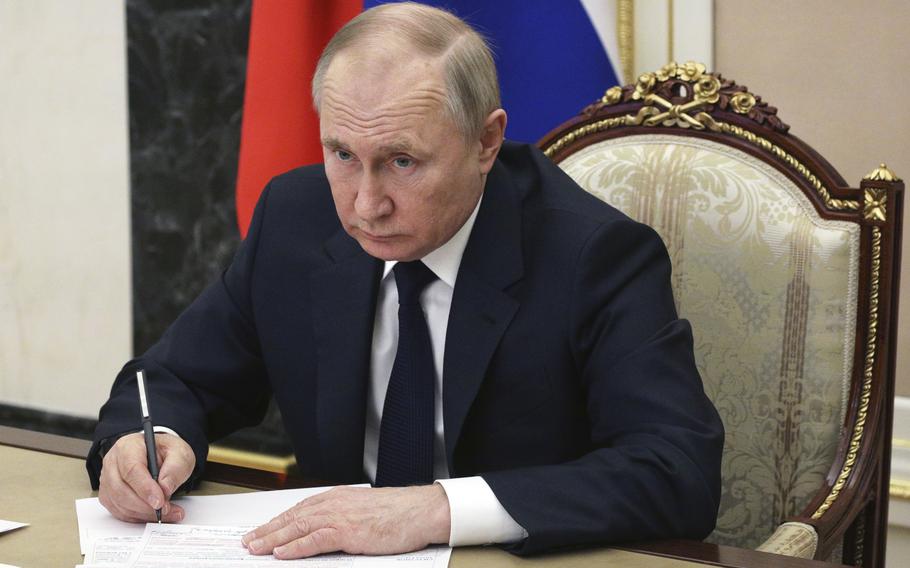
Russian President Vladimir Putin chairs a meeting with members of the government via teleconference in Moscow, Thursday, March 10, 2022. (Mikhail Klimentyev, Sputnik, Kremlin Pool Photo via AP)
Russia slipped closer to a technical default after foreign banks declined to process about $650 million of dollar payments on its bonds, forcing it to offer rubles instead.
While the finance ministry said that it “considers it fulfilled its obligations in full,” neither of the securities involved allowed payment in rubles, according to bond documents. Both notes have a 30-day grace period, data compiled by Bloomberg show.
The U.S. and the European Union imposed tough financial sanctions on Russia after President Vladimir Putin invaded Ukraine late February, hampering its ability to transfer payments to bondholders. Russia has so far sidestepped its first external default in a century, but a U.S. Treasury move this week to halt dollar debt payments from the country’s accounts at U.S. banks has reignited investor concerns.
The cost of insuring Russia’s government debt now signals a record 99% chance of default within a year.
“The default issue is tricky,” said Abdul Kadir Hussain, head of fixed-income asset management at Dubai-based Arqaam Capital. “Russia can claim, ‘We are willing to pay, we have the money to pay, but banks are not letting us pay.’ I’m not sure how the courts would handle that.”
According to the finance ministry, foreign banks rejected payments for bonds maturing earlier this month and for a coupon on notes due April 2042, leaving Russia to send ruble payments to the National Settlement Depository.
JPMorgan Chase, which is the correspondent bank for the bonds, didn’t get approval from the U.S. Treasury to process the transfers due this week, a person familiar with the matter said on Tuesday, asking not to be named because they aren’t authorized to speak publicly. A spokesman for the bank declined to comment.
Russia’s move to pay the debt in rubles “certainly increases the chance of a technical default,” said Gary Kirk, emerging markets portfolio manager at TwentyFour Asset Management. “It is obviously a considerable issue for Russia, and some EM funds.”
Rating firms S&P Global and Fitch Ratings said earlier this year that they would consider Russia being in default if it paid notes in a different currency than the one agreed.
Both firms announced they would withdraw ratings from Russia’s sovereign and corporate debt following EU restrictions that limited their ability to provide such ratings.
In a disconnect with the latest news, the ruble strengthened against the dollar Wednesday, erasing its losses since the invasion. In addition to capital controls that restrict ruble sales, Russia’s exporters -- including its huge oil, gas and metals companies -- are required by law to convert 80% of their earnings into the currency, helping drive it higher
Sanctions on international reserves have frozen an estimated two-thirds of Russia’s $604.4 billion. Reserves shrank by $38.8 billion as of March 25 from the previous report by central bank in February.
Russia defaulted on its ruble debt in 1998. When Putin assumed power in 2000, he pushed the government to keep debt levels low and strive for disciplined fiscal management.
If Russia gets access to its foreign-currency accounts, it will create grounds for the authorities to allow conversion of these rubles into foreign currency, the Finance Ministry said in the statement.
“Russia now has to find a new payment route, quickly,” Lutz Roehmeyer, chief investment officer at Berlin-based Capitulum Asset Management. “If they are doing nothing they will hit the wall called default.”